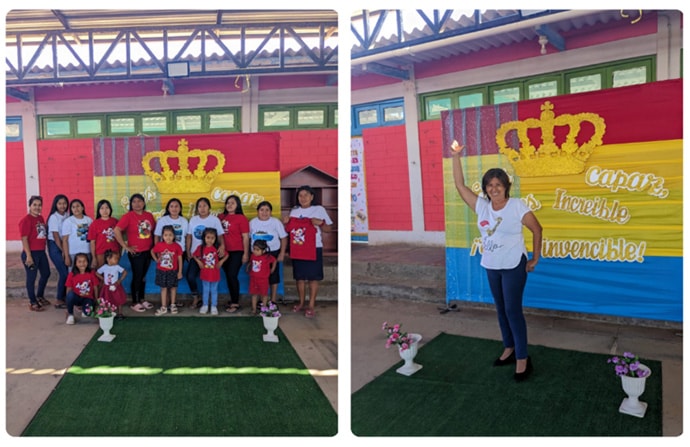By Jenni Ahern, Program Director, Future of Fish Peru
Republished with permission from Future of Fish

You may hear the terms “participatory development”, “co-design” or “co-create” a lot these days as Community and International Development theory continues to evolve. This theory evolves and adapts to human beings and community identified needs, where the most crucial piece of participatory community development is trust building. Trust in process and in people, are the two necessary ingredients for success.
We know that healthy oceans and healthy communities go hand in hand. Future of Fish began working on community development in the La Islilla community in 2021 knowing very few community actors, and very little about the women and their roles in the community. We began executing projects based on cultural identity, leadership, conflict resolution and the identification of sustainable solutions for a healthy community and ecosystem with local leaders. While we were hopeful of taking an outward, explicit and radical gendered approach to our work, because of cultural norms in Northern Peru we had to slowly break down barriers and build up trust within the community for us to begin working directly in women’s empowerment; an exciting and rewarding process.
In mid-2023 we were pleasantly surprised when we were approached via one of our community leaders Ruth, who is in close contact with a group who we call “The Moms.” The Moms contacted Ruth because they wanted to engage with Future of Fish and learn a marketable skill. The Moms range between the ages of 18 and 60, do not know how to read and write, and for the most part have not completed their middle school education. Despite these limitations, they were enthused about learning a new skill and being able to contribute economically to their families. La Islilla is a fishing community that is almost wholly dependent on fishing for their income and livelihood, and in Northern Peru, women rarely fish because of myths, taboos and gendered norms, therefore there are very few economic opportunities for women in La Islilla. As part of our shared and participatory process, in conversation with the Moms and Ruth, we decided on a phased sewing program that would teach women how to sew, then move onto financial literacy and women’s rights as well as the benefits of associativity.

Showcasing the handiwork of “The Moms”
In late 2023 the Moms finished the first stage of their sewing program and concluded with a fashion show, modelling everything from t-shirts to lingerie. The Moms were really happy with what they learned and are eager to continue gaining new experiences and engaging with Future of Fish. We hope that these Moms will continue to engage with us in our diverse community initiatives and be an integral part of the future of food security and diversified incomes in La Islilla via our community composting, waste management pilots and future community gardens.
“Fisheries systems include both fish and people, [therefore] their management should include biological, economic and social considerations”
The success of any community development initiative is one where a development organization, like Future of Fish, can confidently step away from a community in 10-15 years time and the projects and initiatives built will continue to flourish and grow in its absence. Participatory community development and co-design is based on just that. Individual leaders and communities that take ownership of the projects and initiatives co-designed through a participatory process, and no longer need us there. The process of women’s empowerment in a context where women are generally shy and all but invisible, is one of the most exciting and rewarding parts of working in the international development space.
While Future of Fish is a fisheries sustainability organization on paper, in reality, we are so much more than that. Bennett et al. (2021) highlights the benefits of recognizing that “fisheries systems include both fish and people, [therefore] their management should include biological, economic and social considerations” in their article Socio-economic Monitoring and Evaluation in Fisheries. Many frameworks and policies for assessing the health of a fishery include socio-economic indicators, Fishery Improvement Projects (FIPS) for example, use the Social Responsibility Assessment Tool as a framework which includes indicators such as access to basic services for small-scale fishing communities.These systems consider the importance of integrating the monitoring and evaluation of fisheries in their context of a holistic value network in coastal communities; from the extraction of fish itself, to the tourism industry and local restaurants, and the alternative livelihoods that are generated within these communities that ultimately relieve pressure on the fisheries themselves while simultaneously building a more sustainable, resilient and equitable future for coastal communities.
Glossary
Participatory development
A process through which groups and communities determine through inclusive dialogue and consensus 1) their development priorities and 2) the design of solutions that address their priority needs. The responsibility of implementation of a solution lies with the participants. University of New Mexico
Co-design
Co-design is a process of designing with, rather than designing for. Those who are most impacted by the design, especially those with needs least served by existing designs, are involved in the process from its earliest stages. They are engaged throughout the process, and directly contribute to the creation of designs that meet their unique needs. Participants are not involved as research subjects or consultants, rather as designers engaged in active and sustained collaboration. Inclusive Design Research Center
Co-creation
Co-creation is the practice of collaborating with other stakeholders to guide the design process. Participants with different roles align and offer diverse insights, usually in facilitated workshops. Designers can therefore get more holistic views of what a product or service should include. Interaction Design Foundation